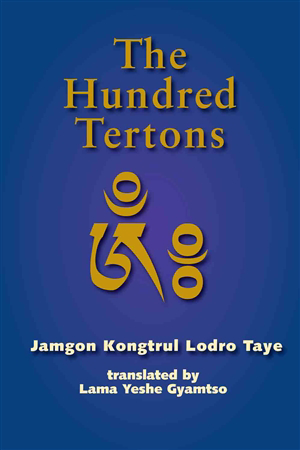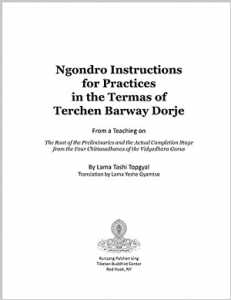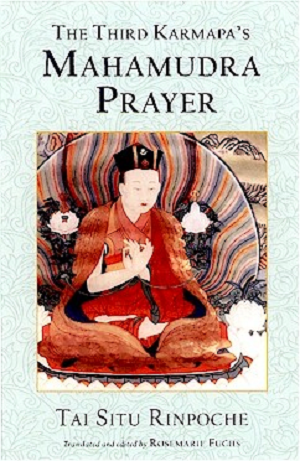The Hundred Tertons by Jamgon Kongtrul Lodro Taye, translated by Lama Yeshe Gyamtso, Book
$32.95 $27.00
Description
Description
Translated by Lama Yeshe Gyamtso
The Hundred Tertons is Jamgon Kongtrul’s history of the visionary men and women who have, again and again, renewed the Vajrayana Buddhist tradition of Padmasambhava. Kongtrul’s book includes biographies of Padmasambhava, his twenty-five disciples, Longchenpa, Jikme Lingpa, Chokgyur Lingpa, and many others. Considered a seminal work of Tibetan Buddhist history, The Hundred Tertons is for the first time available in English translation.
Hardcover, KTD Publications (2012), 388 pp
Translator’s Introduction:
To understand why Jamgon Kongtrul the First (1813-1899) wrote the Hundred Tertons, it is helpful to know the larger context of his writings. The works of Jamgon Kongtrul are collectively known as the Five Treasuries. These are the Treasury of Knowledge, the Treasury of Instructions, the Treasury of Kagyu Mantra, the Treasury of Terma, and the Treasury of Vast Compositions. The Hundred Tertons is part of the first of the sixty-three volumes (in its original publication) of the Treasury of Terma, usually called the Treasury of Precious Terma. Terma means treasure, and includes both teachings that are physically discovered and those that are revealed to the mind of the terton. A terton is a revealer of terma.
When Jamgon Rinpoche had completed his first draft of the Treasury of Knowledge, which he initially intended to be a treatise on the three vows of Buddhism, he gave it to his friend and guru Jamyang Khyentse Wangpo (1820-1892) to review. Khyentse Rinpoche told Jamgon Rinpoche that the treatise would benefit from an autocommentary, given the terseness of the versified root text.
At about the same time Khyentse Rinpoche had a vision of the wisdom dakini Yeshe Tsogyal in the form of the Queen of Great Bliss (the form in which she is meditated upon in the Heart Essence of the Vast Expanse tradition of Khyentse Rinpoches predecessor Jikme Lingpa). Yeshe Tsogyal said to Khyentse Rinpoche, Tell Guna that his present composition is to be one of five treasuries that he shall write and compile. This present one should be expanded to include the ten sciences as well as all Buddhism. By Guna she meant Jamgon Rinpoche, whose monastic name was Yonten Gyamtso, Gunasagara in Sanskrit.
This vision inspired the two great masters to begin the massive project of receiving and compiling the diverse teachings that now make up the Five Treasuries, which had previously been prophesied by the Buddha himself. It is due to their work that many lineages that would otherwise have died out subsequent to the Communist invasion of Tibet have survived.
In a tantra of the Great Perfection the following is written:
If the history of the teachings is not taught
The authenticity of guhyamantra will be in doubt.
As indicated by the above, it was obvious to Jamgon Rinpoche that an account of the lives of the tertons whose termas are presented in the Treasury of Precious Terma was needed. Accordingly, he wrote the Hundred Tertons.





